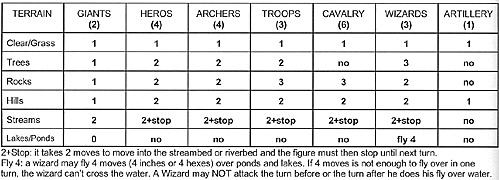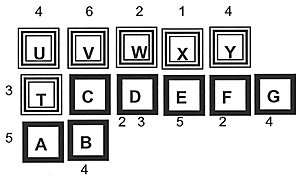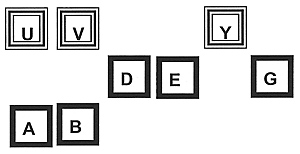This set of miniature rules was crafted by a long time miniature gamer who had four young children with whom he thought it would be fun to share his hobby with. The rules were crafted with several things in mind, simple is fun and fast, no card decks, and 8-10 year old's have limited attention spans, so keep the numbers small and the game moving.
KIMMIRIA is based on 25mm scale miniatures. Painted miniatures, preferably by the children. Can they use unpainted miniatures? Sure, but at a -1 penalty to any and all die rolls that the unpainted figure makes. How's that for subtle. Using smaller or larger scales and figures is no problem, just convert the numbers up or down to suit the scale. KIMMIRIA uses single figures, so you don't have to worry about unit sizes and basing conventions. The game also uses a fair number of standard six sided dice, available in most children's games. So let's play.
There are six different types of figures the rules use: GIANTS, HERO'S (or HEROINES) ARCHERS, TROOPS, CAVALRY and WIZARDS/ARTILLERY.
GIANTS are any very large figure, such as giants, ents, ogres, dragons, dinosaurs and others.
HERO'S and HEROINE'S are special figures that for any reason are different from the rest of the figures: especially good paint job, looks like a Hero type, heroic weapons or stance.
ARCHERS are bow or cross-bow armed fighters, slingers with stone throwers, even rock throwing goblins.
TROOPS are your good old regular fighters: any kind of weapon and armor, can be painted to look alike or different, being the same race is helpful.
CAVALRY are troops mounted on some creature that moves fast: knights on horseback, goblins on wolves, lizards on dinosaurs and others. CAVALRY can be either armed like ARCHERS or like TROOPS, but not both.
WIZARDS and ARTILLERY fall into the same category, really long range weapons. WIZARDS can be any type of magic casting figure, ARTILLERY can be either the ancient type of stone caster (catapult) or bolt thrower (ballista), or medieval type of cannon (bombard), or an earth elemental throwing rocks.
ORDER OF PLAY:
1 Missile Fire: BOTH sides may fire at missiles at each other. Missiles are defined as arrows, cross-bow bolts, rocks from slingers, boulders from giants (in other words stuff ARCHERS use), then magic from WIZARDS, last weapons from ARTILLERY.
2: Roll for Initiative: Each player rolls one d6. High roll goes first. Ties are re-rolled.
3: Roll for Groups to Move: Player with initiative rolls one d6. This is the number of GROUPS of figures that player can move.
4: Move: Player with initiative moves his groups of figures, remembering to take into account the slowest type in the group and the type of terrain being moved through.
5: Combat: After movement any figure touching (in base to base contact) an enemy figure MUST fight that figure. Sometimes one figure touches several figures and then must fight them all.
6: Victory Conditions: Check for winning victory conditions during the game. The players can decide the victory conditions themselves, but we suggest one of the following:
- A: Destroy all the enemy figures.
B: Destroy half the figures and the enemy surrenders.
C: Destroy ten of the figures (for really big battles).
MOVEMENT:
Who moves first? Each side rolls a six sided die, high die gets to moves first. This is called Initiative. The Player that is moving is called the Attacker. The Attacker then rolls another six sided die. This is the number of groups of figures he can move. What's a group? A single figure all by itself can be a group. A bunch of figures, all close to one another (bases touching, or very close to each other or next to each others grid or hex if playing on a gridded map sheet) is a group. A player can split off figures from groups without any problem. And she can add figures into groups without trouble. But beware, a player will never be able to move more than six (6) groups in any one turn.
Any figure can move. Figures have different movement capabilities, which are called movement rates. That's the number in (parentheses) underneath the figure type in the table below. Groups move at the slowest movement depending on what types of figures are in the group. For example, a group of 2 Troops and 1 Giant would move at 2 units of movement. And what type of ground they are moving through makes them move differently. Figures move differently depending on what surface you are playing on. If you are playing on a standard grid, or a hex grid colored map, then the unit of movement is one square or hex. If you are playing on the floor or tabletop, then you will need a ruler, because the unit of movement is one inch (1") for 25mm figures. Take a look at the table below:

2+ Stop: it takes 2 moves to move into the streambed or riverbed and the figure must then stop until next turn. Fly 4: a wizard may fly 4 moves (4 inches or 4 hexes) over ponds and lakes. If 4 moves is not enough to fly over in one turn, the wizard can't cross the water. A Wizard may NOT attack the turn before or the turn after he does his fly over water.
So what happens when you are moving through different types of terrain? Here's an example: A group of 3 Troops and 1 Hero start off in a clear space. The space you start in never counts against you. The group has a movement rate of 3, because the lowest rate is the troops' 3. So the group could move INTO three clear spaces, or one rock space, or one clear and one tree, or one clear and one hill, or one clear and one stream. What happens when the stream is first to be moved into? The group must stop, even though there is one move left, because streams cause you to stop when entering them. That includes going up stream and down stream, by the way.
One last thing about movement once a figure moves next to (even corner to corner) an enemy figure, it must stop. This is called being engaged. Until the enemy figure is destroyed you may only slide one unit of movement around the enemy. You may not move away from the enemy. You can free turn your figure to face an enemy if she is on your side during your turn.
COMBAT:
All figures may fight. Figures fight with different Fighting Values (FV's). When fighting, one figure may attack only one other figure it is next to. You can gang up on figures, though. Up to six figures may attack a single enemy figure. You must be next to (across or corner to corner) the figure you are going to attack, unless the figure attacking is the ARCHER, WIZARD or ARTILLERY. They can attack either from a long range (their best attack) or from up close (not the best attack). There are two types of fighting: Missile Fire (Long Range Combat) and Melee (Close Combat).
Missile Fire is done by Archers, Archer type Cavalry, Wizards and Artillery. Missile Fire takes place BEFORE Movement. Missile fire is very simple. The attacker rolls one die, the defender rolls one die for each figure and adds his Armor Plus number to the number he rolled. The attackers wins when his number is larger than the defenders. Ties go to the defender, except with magic attacks by WIZARDS, who win all ties. ARTILLERY attacks are not effected by Armor Plus. Remove the figures that lost against the missiles AFTER everyone has fired their missiles. This includes other missile firing figures. Mark the dead guys with something simple like pennies. What all this means is that each missile firing figure gets to fire its full number of attacks before it is killed and removed from the table.

The two numbers for Cavalry are for the Troop type (Knights) and Archer type (Horse Archers) respectively.
Now that we know how to shoot, who can we shoot? Rule number one is that you have to shoot at the closest enemy target. Use a ruler. If two targets are really close to the same distance, choose with a die roll which one is closer.
Rule number two is harder you have to have a clear path to shoot your missiles. Missiles will go into (and out of) trees and rocks, but only a half inch or half hex. And you can shoot anything on top of a hill or on the front slope of the hill, but not behind the hill or on the back slope of the hill. So if an enemy is behind a group of trees or rocks or hills, you cannot see it or shoot at it. You cannot shoot into a group of engaged figures. Sorry, you might hit your own figures, and that is called "a bad thing." With arrows, bolts and rocks (ARCHER stuff), you only need a thin clear path to see and hit your target. Turn your ruler on its side. Lay if from the center of the shooting figure to the center of the target figure. If the side of the ruler goes through or touches anything that you cannot see through (like trees, rocks, all of a hill, other figures), you cannot shoot at the target.
WIZARDS and ARTILLERY require a bigger clear path to shoot. They need a path the size of the full width of the ruler. WIZARD magic attacks effect up to two enemy figures that are next to one another, and ARTILLERY attacks effect up to three enemy figures that are all in the same group, and all touching each other. Everybody should have the same type of ruler to make this rule work fairly.
Melee Combat is easy. Melee takes place after Movement. A figure that is next to an enemy figure (who may have attacked him last turn) is considered engaged and cannot move away. The moving player is the attacker. Sometimes he chooses who is attacking whom. All figures that are next to enemy figures must attack. Roll one die for each figure involved in the fight. Put the die next to the figure. After all the figures have their dice rolled, the highest number rolled (usually sixes) goes and attacks first. Add the die roll to the Fighting Value for each figure. Compare the two numbers. Highest number wins. One figure may engage many figures but can only kill one figure.

Trees: All figures add +1 defending in woods, except GIANTS, CAVALRY and ARTILLERY
Rocks: All figures add +1 defending in rocks unless attacked by the HERO
The two numbers for Cavalry are for the Troop type (Knights) and Archer type (Horse Archers) respectively.
When a figures loses a melee combat, remove it from the table. After all melee combats are finished, the Attacking player gets a free move into any of the spaces left empty by defeated enemy figures. You may only move one figure one space into the defeated enemies space.
Doing single figure versus single figure melee combats is easy. Highest modified die roll wins and the losing figure gets removes from the table. It gets much more complex when there are two groups of figures fighting each other. Simple rule: you attack the figure across from you first. If there is no figure across, you may attack one a-corner. Here's a fairly complex example to show how it all works. For the purpose of this example, all the figures are TROOPS. And the player with figures A-G has the initiative and is the attacker. Figures T-Y are the defenders.

Set up your figures and go through this with us. Every figure in combat has had a d6 die roll done and placed next to it. That's what the lonely numbers are for. Player A-G is the attacker, and would normally go first, but remember high die roll goes first in melee combat. So the V with a 6 goes first. It must go against C, because C is across, even though V could attack D, but D is only a corner. Since all troops have the same fighting value, we'll only need to compare the die rolls. V's 6 kills C and C is removed. Next are the 5's, A and E. A has only one target (T, a 3) which it kills. E has three targets (W, X and Y) and must go against X, who is across. E (5) kills X (1). Next are the fours, B, G, U and Y. B has no target anymore, it was killed by A. G is a-corner from Y, which is also a 4. A tie results, and nobody dies. Both figures must stay in place and fight it out again next turn. U was a corner from C (a 2) but it was killed by V. Next is three. The only remaining three is D (T was killed by A). D is across from W (a 2) and kills it. There is a single 2 left: F. Poor F, it is engaged by Y (a 4),and even though Y and G are locked in melee for next round, Y and its 4 kills the lowly F.
This is what it looks like after the combat ends. D, A and E may move one space into the spaces of the enemy they killed because they were the attackers and won their combats.

KIMMIRIA is printed by NMPI, 5715 Menaul Blvd, NE Albuquerque, New Mexico 87110. Copyright 2002 The author retains all rights, and will gladly answer any and all inquiries and comments. Enjoy. KPR
Back to Strategikon Vol. 1 No. 4 Table of Contents
Back to Strategikon List of Issues
Back to MagWeb Master Magazine List
© Copyright 2002 by NMPI
This article appears in MagWeb (Magazine Web) on the Internet World Wide Web. Other military history articles and gaming articles are available at http://www.magweb.com